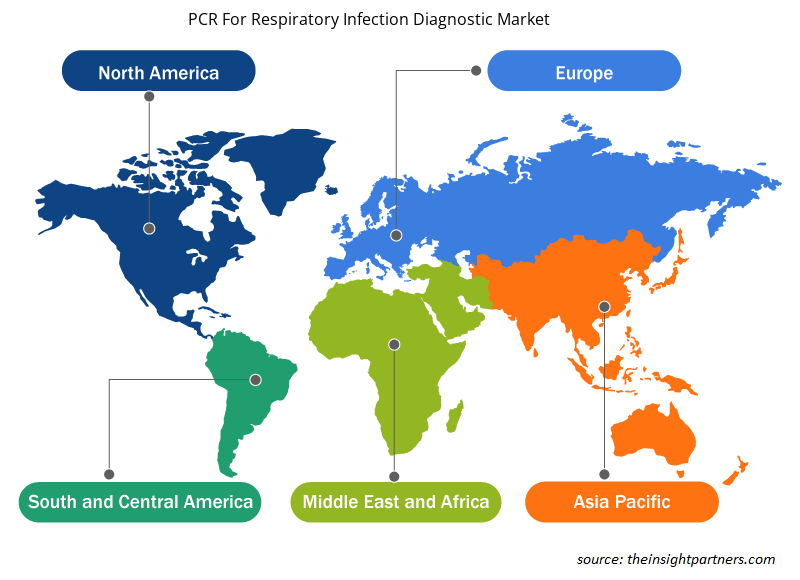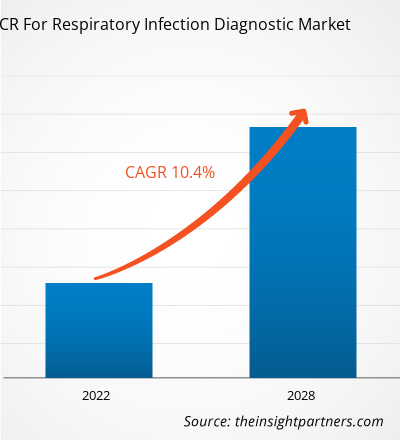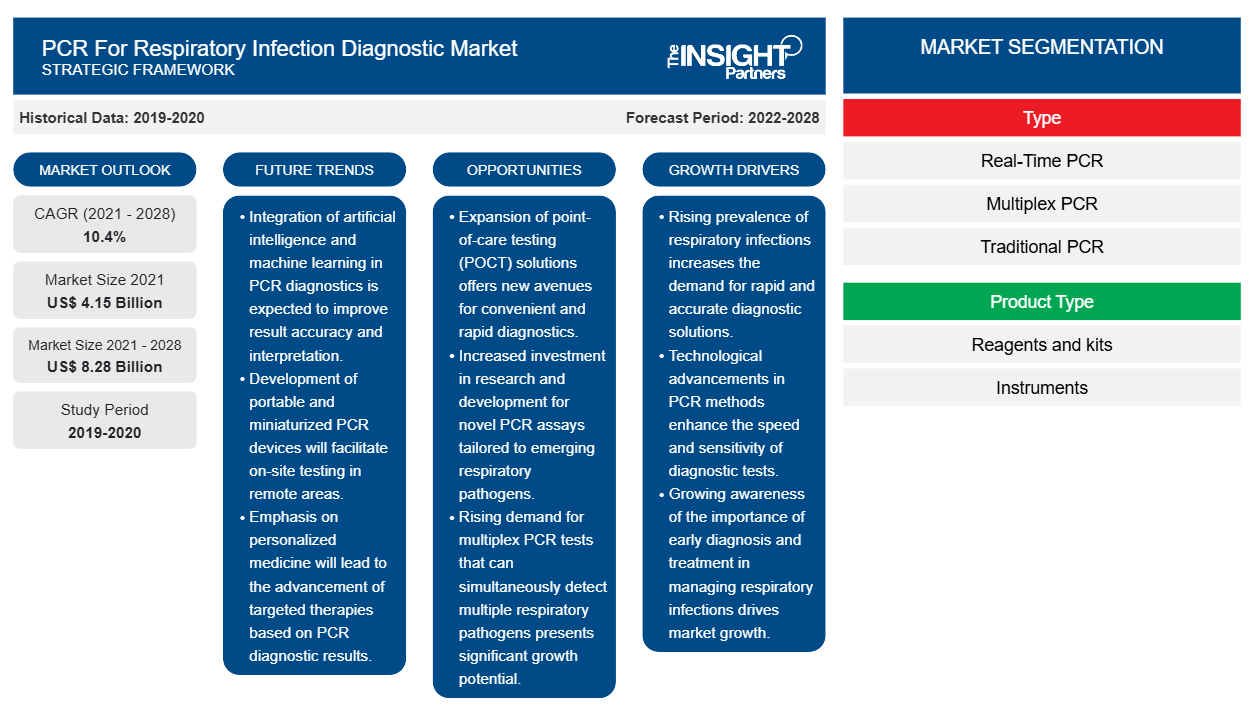Le marché de la PCR pour le diagnostic des infections respiratoires a été évalué à 8 279,32 millions USD en 2028, contre 4 146,02 millions USD en 2021 ; il devrait croître à un TCAC de 10,4 % de 2021 à 2028.
La réaction en chaîne par polymérase (PCR) est utilisée pour des diagnostics précis au point de service qui aident à identifier et à déterminer rapidement la cause des infections des voies respiratoires. De plus, la PCR est largement préférée dans les milieux hospitaliers et ambulatoires, ce qui contribue à stimuler la croissance du marché ces dernières années.
La croissance du marché du diagnostic des infections respiratoires par PCR est due à des facteurs tels que la charge croissante des maladies respiratoires chroniques (MRC), les développements croissants dans les tests PCR, qui améliorent considérablement les performances des dispositifs médicaux. Cependant, l'utilisation des tests PCR pour divers diagnostics d'infections respiratoires et les développements de la technologie PCR utilisés pour les obtenir. La disponibilité de tests alternatifs freine la croissance du marché.
Personnalisez ce rapport en fonction de vos besoins
Vous bénéficierez d'une personnalisation gratuite de n'importe quel rapport, y compris de certaines parties de ce rapport, d'une analyse au niveau des pays, d'un pack de données Excel, ainsi que de superbes offres et réductions pour les start-ups et les universités.
- Obtenez les principales tendances clés du marché de ce rapport.Cet échantillon GRATUIT comprendra une analyse de données, allant des tendances du marché aux estimations et prévisions.
Informations sur le marché
Stratégies de consolidation du marché adoptées par l'utilisation des tests PCR pour divers diagnostics d'infections respiratoires
Le test PCR est la référence absolue pour la détection des maladies infectieuses respiratoires, notamment du SARS-CoV-2. En outre, les développements croissants du PCR ne se limitent pas au test COVID-19. Les développements technologiques continus ont permis aux chercheurs de développer des techniques PCR avancées à un coût réduit et de limiter leur complexité. On s'attend à ce que le test PCR améliore ses capacités de diagnostic moléculaire et renforce son rôle à l'avenir avec les développements continus de technologies telles que la microfluidique et le séquençage de nouvelle génération . En outre, le test PCR est largement utilisé dans des institutions telles que les maisons de retraite, les établissements de soins chroniques et les hôpitaux, pour identifier l'infection par le virus de la grippe qui provoque des épidémies respiratoires.
De plus, les infections respiratoires aiguës et chroniques sont parmi les principales causes de morbidité dans les pays développés et en développement à l'échelle mondiale. On estime que les maladies respiratoires aiguës représentent près de 75 % du total des morbidités aiguës dans le monde. Par conséquent, diverses entreprises proposent divers kits PCR capables de détecter la présence d'agents pathogènes à l'origine de maladies respiratoires. Par exemple, des entreprises telles que bioMérieux SA et altona Diagnostics GmbH proposent une large gamme de kits PCR capables de détecter les infections respiratoires aiguës dans les voies respiratoires supérieures ou inférieures. Outre l'incidence croissante des maladies respiratoires aiguës et chroniques, d'autres facteurs tels que les conditions environnementales et climatiques, la pollution de l'air et la découverte de nouvelles bactéries, virus et agents pathogènes sont susceptibles de constituer des opportunités de croissance vitales pour les tests PCR pour le diagnostic des infections respiratoires dans un avenir proche.
Informations basées sur les types
Le marché de la PCR pour le diagnostic des infections respiratoires, par type, est segmenté en PCR en temps réel (qPCR), PCR multiplex, PCR traditionnelle, PCR numérique, transcriptase inverse (RT-PCR) et autres. Le segment de la PCR en temps réel (qPCR) détenait la plus grande part du marché en 2021 et devrait enregistrer le TCAC le plus élevé du marché au cours de la période de prévision.
Informations basées sur le type de produit
En fonction du type de produit, le marché du diagnostic des infections respiratoires par PCR est segmenté en réactifs et kits, instruments et autres. Le segment des réactifs et kits détenait la plus grande part du marché en 2021 et devrait enregistrer le TCAC le plus élevé du marché au cours de la période de prévision.
Informations basées sur le type d'infection
En fonction du type d'infection, le marché du diagnostic des infections respiratoires par PCR est segmenté en infections bactériennes, infections virales et infections fongiques et autres agents pathogènes. En 2021, le segment des infections virales détenait la plus grande part du marché et devrait enregistrer le TCAC le plus élevé du marché au cours de la période de prévision.
Informations basées sur les utilisateurs finaux
En fonction de l'utilisateur final, le marché du diagnostic des infections respiratoires par PCR est segmenté en hôpitaux, cliniques médicales, laboratoires cliniques, établissements universitaires et de recherche, sociétés biotechnologiques et pharmaceutiques, etc. En 2020, le segment des laboratoires cliniques détenait la plus grande part du marché et devrait enregistrer le TCAC le plus élevé du marché au cours de la période de prévision.
Les lancements et les approbations de produits sont les stratégies couramment adoptées par les entreprises pour étendre leur présence mondiale et leurs portefeuilles de produits. De plus, les acteurs du marché de la reconstruction mammaire se concentrent sur la stratégie de collaboration pour élargir leur clientèle, ce qui, à son tour, leur permet de maintenir leur nom de marque à l'échelle mondiale.
Aperçu régional du marché du diagnostic des infections respiratoires par PCR
Les tendances et facteurs régionaux influençant le marché du diagnostic des infections respiratoires par PCR tout au long de la période de prévision ont été expliqués en détail par les analystes d’Insight Partners. Cette section traite également des segments et de la géographie du marché du diagnostic des infections respiratoires par PCR en Amérique du Nord, en Europe, en Asie-Pacifique, au Moyen-Orient et en Afrique, ainsi qu’en Amérique du Sud et en Amérique centrale.

- Obtenez les données régionales spécifiques pour le marché du diagnostic des infections respiratoires par PCR
Portée du rapport sur le marché du diagnostic des infections respiratoires par PCR
| Attribut de rapport | Détails |
|---|---|
| Taille du marché en 2021 | 4,15 milliards de dollars américains |
| Taille du marché d'ici 2028 | 8,28 milliards de dollars américains |
| Taux de croissance annuel moyen mondial (2021-2028) | 10,4% |
| Données historiques | 2019-2020 |
| Période de prévision | 2022-2028 |
| Segments couverts | Par type
|
| Régions et pays couverts | Amérique du Nord
|
| Leaders du marché et profils d'entreprises clés |
|
Densité des acteurs du marché du diagnostic des infections respiratoires par PCR : comprendre son impact sur la dynamique commerciale
Le marché du diagnostic des infections respiratoires par PCR connaît une croissance rapide, tirée par la demande croissante des utilisateurs finaux en raison de facteurs tels que l'évolution des préférences des consommateurs, les avancées technologiques et une plus grande sensibilisation aux avantages du produit. À mesure que la demande augmente, les entreprises élargissent leurs offres, innovent pour répondre aux besoins des consommateurs et capitalisent sur les tendances émergentes, ce qui alimente davantage la croissance du marché.
La densité des acteurs du marché fait référence à la répartition des entreprises ou des sociétés opérant sur un marché ou un secteur particulier. Elle indique le nombre de concurrents (acteurs du marché) présents sur un marché donné par rapport à sa taille ou à sa valeur marchande totale.
Les principales entreprises opérant sur le marché du diagnostic des infections respiratoires par PCR sont :
- Abbott
- F. Hoffmann-La Roche AG
- Hologic, Inc.
- Seegene Inc.
- AusDiagnostics
Avis de non-responsabilité : les sociétés répertoriées ci-dessus ne sont pas classées dans un ordre particulier.

- Obtenez un aperçu des principaux acteurs du marché du diagnostic des infections respiratoires par PCR
Par type
- PCR en temps réel (qPCR)
- PCR multiplexée
- PCR traditionnelle
- PCR numérique
- Transcriptase inverse (RT-PCR)
- Autres
Par type de produit
- Réactifs et kits
- Instruments
- Autres
Par type d'infection
- Infections bactériennes
- Bordetelle
- Streptococcus pneumoniae
- Staphylococcus aureus
- Haemophilus influenzae
- Moraxella catarrhalis
- Mycoplasma pneumoniae
- Chlamydophila pneumoniae
- Legionella
- Autres
- Infections virales
- Rhinovirus
- Virus de la grippe
- Virus CoV-2 du syndrome respiratoire aigu sévère (SRAS)
- Virus respiratoire syncytial (VRS)
- Adénovirus
- Entérovirus
- Para-influenza
- Métapneumovirus humain (hMPV)
- Autres
- Champignons et autres agents pathogènes
Par utilisateur final
- Hôpitaux
- Cliniques médicales
- Laboratoires cliniques
- Institutions académiques et de recherche
- Sociétés de biotechnologie et pharmaceutiques
- Autres
Par géographie
- Amérique du Nord
- NOUS
- Canada
- Mexique
- Europe
- France
- Allemagne
- ROYAUME-UNI
- Espagne
- Pays-Bas
- Norvège
- Italie
- Reste de l'Europe
- Asie-Pacifique (APAC)
- Chine
- Inde
- Japon
- Australie
- Corée du Sud
- Reste de l'Asie-Pacifique
- Moyen-Orient et Afrique (MEA)
- Arabie Saoudite
- Émirats arabes unis
- Afrique du Sud
- Reste du Moyen-Orient et de l'Afrique
- Amérique du Sud et Amérique centrale (SCAM)
- Brésil
- Argentine
- Reste de l'Amérique du Sud et de l'Amérique centrale
Profils d'entreprise
- Abbott
- F. Hoffmann-La Roche AG
- Hologic, Inc.
- Seegene Inc.
- AusDiagnostics
- BD
- Laboratoires Bio-Rad Inc.
- BioMérieux
- Qiagen
- Thermo Fisher Scientific Inc
- Analyse historique (2 ans), année de base, prévision (7 ans) avec TCAC
- Analyse PEST et SWOT
- Taille du marché Valeur / Volume - Mondial, Régional, Pays
- Industrie et paysage concurrentiel
- Ensemble de données Excel
Rapports récents
Témoignages
Raison d'acheter
- Prise de décision éclairée
- Compréhension de la dynamique du marché
- Analyse concurrentielle
- Connaissances clients
- Prévisions de marché
- Atténuation des risques
- Planification stratégique
- Justification des investissements
- Identification des marchés émergents
- Amélioration des stratégies marketing
- Amélioration de l'efficacité opérationnelle
- Alignement sur les tendances réglementaires





















 Obtenez un échantillon gratuit pour - PCR pour le marché du diagnostic des infections respiratoires
Obtenez un échantillon gratuit pour - PCR pour le marché du diagnostic des infections respiratoires